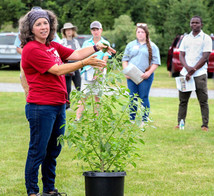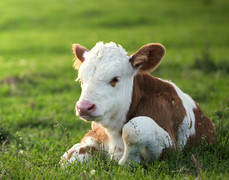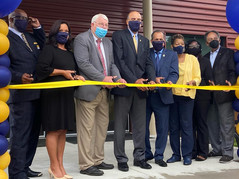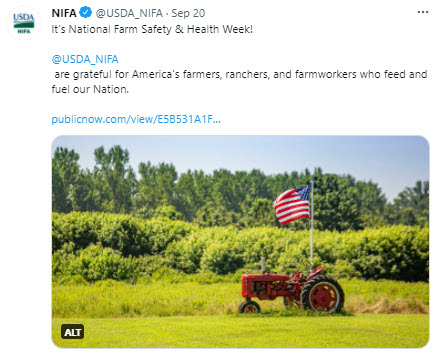
USDA and HHS Launch Resource Guide to Help Rural Communities Increase Access to Child Care Services
USDA’s Deputy Under Secretary for Rural Development Justin Maxson and Department of Health and Human Services Deputy Assistant Secretary for Early Childhood Development Katie Hamm unveiled a joint resource guide to help people in rural and Tribal communities increase access to childcare services. For more information, read the USDA press release.
Early Childhood Development Joint Resource Guide cover, courtesy of the USDA.
|

Building a More Resilient Beef Supply Chain
Shocks to the U.S. beef supply chain the past two years has led to discussions and studies on how to improve resiliency throughout the system. USDA’s Rod Bain talks with University of Missouri Extension Specialist Keri Jacobs, Purdue University Extension Specialist Jayson Lusk, University of Minnesota's Jennifer van de Ligt, and economic experts of the livestock sector on ways that product availability is maintained and supply disruptions minimized during supply chain critical times. For more information, read the USDA broadcast.
Beef industry production and supply chain graphic, courtesy of Getty Images.
|

NIFA Career Opportunities
We are hiring! The National Institute of Food and Agriculture (NIFA) recruits a diverse group of talented, creative, motivated professionals who are invested in shaping the future of food and agricultural science. We offer a variety of benefits and services to our employees that focus on work-life balance, career enhancement, and health and well-being. NIFA has career opportunities in a variety of scientific disciplines covering engineering, food science, forestry, education, animal and crop sciences, and many other agriculture-related disciplines. NIFA job openings are listed on USAJobs. Current NIFA job openings are for Kansas City, Missouri, or location negotiable after selection.
Secretary (OA) (GS 6-7)
Closing Date: September 30, or when we have received 150 applications
View the merit promotion job announcement (mainly for government employees)
|

Projects Aim to Manage Weeds in Organic Fruit, Hemp Farming
Weed control is a problem as old as agriculture itself, but two projects from a Cornell University researcher aims to cultivate new methods for zapping the pesky plants, benefitting organic apple and grape growers, and hemp producers in New York state and around the country. Cornell University Assistant Professor Lynn Sosnoskie is collaborating on a $2 million project to study electric weed control in perennial fruit crops. She is also leading a $325,000 weed management study for hemp. Both studies are multi-institution, multistate undertakings that aim to provide growers with evidence-based, location-specific recommendations to suppress weeds and maximize yields. Funded by USDA’s National Institute of Food and Agriculture. For more information, read this Cornell Chronicle article.
Cornell University Assistant Professor Lynn Sosnoskie discusses weed management strategies, courtesy of Cornell University.
|

Eliminating Beef Cattle Pregnancy Loss with CRISPR/Cas9 Technology
Calves on the ground eventually mean dollars in the pocket and steaks in the meat case. It’s the basics of the beef industry. However, reproductive inefficiency costs the beef industry billions every year. Most of that is driven by embryonic mortality and pregnancy loss, said Texas A&M University Associate Professor Ky Pohler. “We’re conducting a series of studies to evaluate what’s really important to the developing pregnancy,” Pohler said. “We want to determine how much of the loss is coming from the physiology of the animal vs. how much is genetic.” A recent $500,000 Agriculture and Food Research Initiative grant from USDA’s National Institute of Food and Agriculture will fund Pohler’s project to advance understanding of embryonic mortality and pregnancy loss in the cow. For more information, read this Texas A&M AgriLife Today article.
Brown and white calf in a floral pasture, courtesy of Adobe Stock.
|

Ribbon Ceremony to Celebrate the Farm Pavilion
In honor of the opening of the new Extension and Research Farm Pavillion, a ribbon ceremony was held at North Carolina A&T State University Farm on McConnell Road. The 17,000 square foot pavilion includes an auditorium, laboratories, demonstration kitchen, a 50-person classroom and a 400-person conference room for the College of Agriculture and Environmental Sciences department. The project is worth $5 million, and it is funded by USDA’s National Institute of Food and Agriculture. North Carolina A&T and North Carolina State University established a research partnership in 2012 to help with agricultural programs and supporting small-scale farmers in North Carolina. For more information, read The A&T Register article.
N.C. A&T hosts Ribbon Ceremony
|
Article Named Best Paper of 2021 by Journal of Environmental Quality
A research article by Iowa State University and USDA Agricultural Research Service (ARS) scientists has received the 2021 Best Paper Award from the Journal of Environmental Quality. The award, announced September 16, recognizes the top scientific paper from the last two years. The article, “In Situ Denitrification in Saturated Riparian Buffers,” published in March 2019. The study reported in the winning article was supported by USDA’s National Institute of Food and Agriculture and the Iowa Nutrient Research Center at Iowa State University. For more information, read this Iowa State University article.

Prioritizing Nutrition Security: Emerging Approaches in Research and Practice
Learn about emerging approaches to prioritizing nutrition security in research and practice at an upcoming webinar on September 27 from 3 to 4:30 p.m. ET. Program experts from academic, local public health administration, and the largest domestic food bank network will provide overviews of their emerging approaches and challenges to prioritizing nutrition security. Attendees are highly encouraged to ask questions during the live Q&A segment. This event is the fourth installment of NIFA’s monthly Nutrition Security Webinar Series. The series is set to feature a broad range of topics and speakers focused on prioritizing nutrition security during and beyond the COVID-19 pandemic. Go online to register or for more information. After registering, you will receive a confirmation email with details on how to join the live session.
Food nutrition security graphic, courtesy of Getty Images.
|

Hispanic-Serving Institutions (HSI) Civil Rights Overview
October 6 at 3 p.m. ET
NIFA’s Civil Rights and Equal Opportunity office is expanding its grantee civil rights compliance review program to include Hispanic-serving Institutions. This webinar will introduce NIFA’s civil rights staff and explain our civil rights compliance review process, including the overall purpose, goals, stages and timeline of a civil rights review, as well as different civil rights review areas. This webinar is open to your institution’s diversity and inclusion officer, Title IX coordinator, and/or federal compliance specialist to learn how NIFA will be ensuring civil rights compliance by, and providing technical assistance to, NIFA-funded Hispanic-serving institutions moving forward. Go online to register or for more information.
Webinar graphic, courtesy of Adobe Stock.
|
NIFA Invests $6 Million in Science that Analyzes the Risks of Introducing New Biotechnologies
NIFA recently awarded 14 Biotechnology Risk Assessment Grants (BRAG) Program grants to support risk assessment, mitigation, and containment research pertaining to the introduction of genetically engineered organisms into the environment. BRAG projects will provide federal policy makers with scientific knowledge to identify and develop appropriate management practices to minimize any risks associated with genetically engineered animals, plants, and microorganisms.
NIFA Invests $2.9 Million for Research and Extension on Alfalfa Productivity, Resilience, Quality, and Marketing
NIFA recently awarded five grants for integrated research to increase alfalfa yield and quality; improve harvest and storage systems; and extension efforts to support alfalfa marketing through better yield and quality estimate methods. These grants are part of the Alfalfa Seed and Alfalfa Forage System Program (ASAFS), which supports collaborative research and extension to improve efficiency and sustainability of conventional and organic alfalfa production. AFRP encourages projects that bring together expertise from multiple disciplines, organizations, and states, for greater impact and for enhanced effectiveness of limited state, federal, and industry resources.
NIFA Invests over $900,000 for Canola and Hemp Research
NIFA recently awarded five awards through the Supplemental and Alternative Crops (SAC) Competitive Grants Program. SAC supports projects that lead to expanded adaptation and increased acres in the United States of canola grown for oil and industrial hemp grown for value-added products. SAC supports the breeding, testing, and development of superior performing canola and industrial hemp varieties and production practices that result in improved cost efficiencies, reduced grower risks, and wider use in production systems. Research results and technology developed are expected to be rapidly transferred to producers and other users through effective Extension outreach and other engagement efforts.
Centers of Excellence at 1890 Institutions (1890 COEs)
 Image of two college students, courtesy of Adobe Stock.
The 1890 Centers of Excellence (COEs) Program provides support to: improve rural prosperity in underserved farming communities; address critical training and development needs; and increase participant diversity in science, technology, engineering, agriculture, and mathematics. The 1890 COEs were established in 2015 in conjunction with the 125th Anniversary of the Second Morrill Act of 1890 and are hosted by 1890 Land-grant Institutions. For more information, read the full COEs funding opportunity.

|